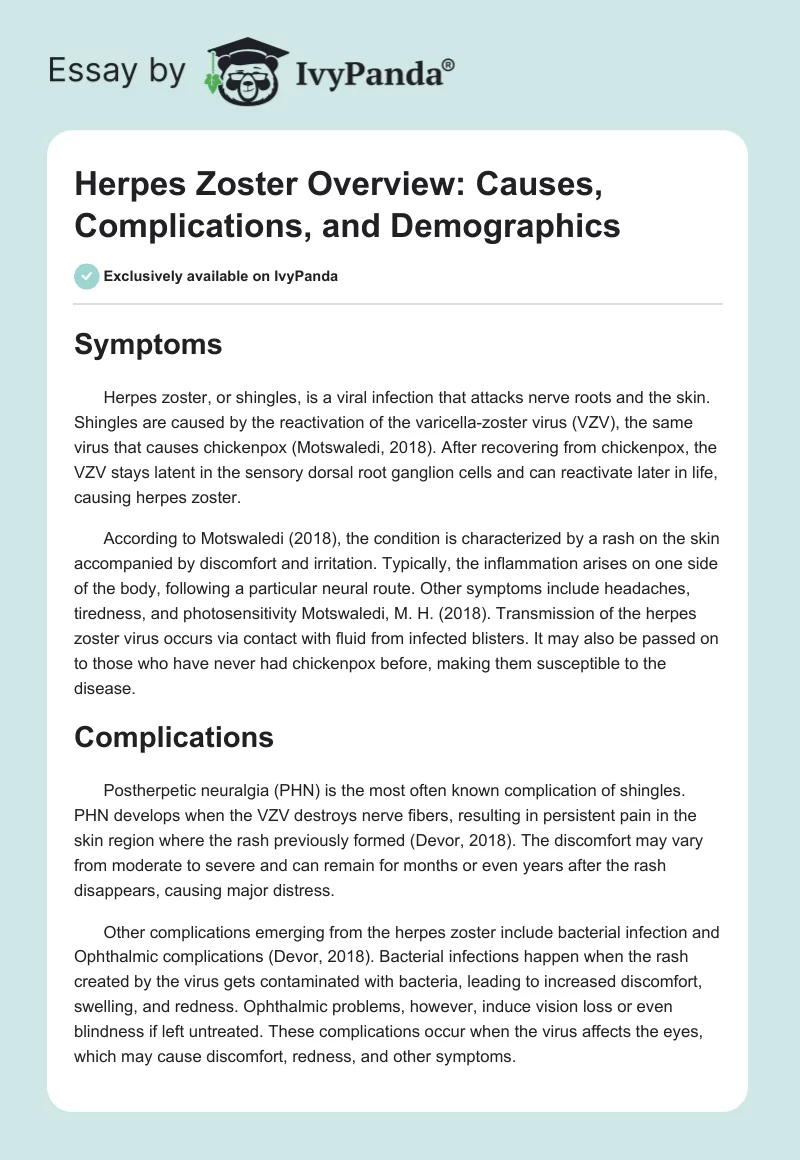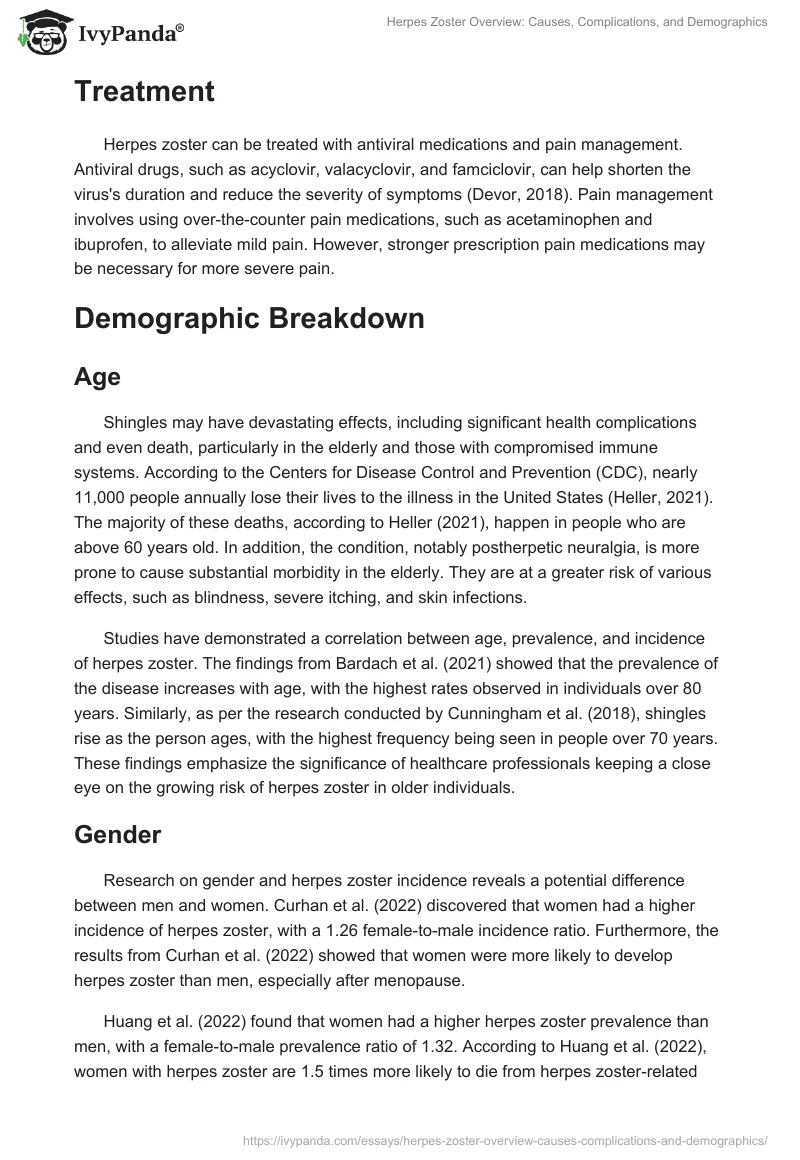Symptoms
Herpes zoster, or shingles, is a viral infection that attacks nerve roots and the skin. Shingles are caused by the reactivation of the varicella-zoster virus (VZV), the same virus that causes chickenpox (Motswaledi, 2018). After recovering from chickenpox, the VZV stays latent in the sensory dorsal root ganglion cells and can reactivate later in life, causing herpes zoster.
According to Motswaledi (2018), the condition is characterized by a rash on the skin accompanied by discomfort and irritation. Typically, the inflammation arises on one side of the body, following a particular neural route. Other symptoms include headaches, tiredness, and photosensitivity Motswaledi, M. H. (2018). Transmission of the herpes zoster virus occurs via contact with fluid from infected blisters. It may also be passed on to those who have never had chickenpox before, making them susceptible to the disease.
Complications
Postherpetic neuralgia (PHN) is the most often known complication of shingles. PHN develops when the VZV destroys nerve fibers, resulting in persistent pain in the skin region where the rash previously formed (Devor, 2018). The discomfort may vary from moderate to severe and can remain for months or even years after the rash disappears, causing major distress.
Other complications emerging from the herpes zoster include bacterial infection and Ophthalmic complications (Devor, 2018). Bacterial infections happen when the rash created by the virus gets contaminated with bacteria, leading to increased discomfort, swelling, and redness. Ophthalmic problems, however, induce vision loss or even blindness if left untreated. These complications occur when the virus affects the eyes, which may cause discomfort, redness, and other symptoms.
Treatment
Herpes zoster can be treated with antiviral medications and pain management. Antiviral drugs, such as acyclovir, valacyclovir, and famciclovir, can help shorten the virus’s duration and reduce the severity of symptoms (Devor, 2018). Pain management involves using over-the-counter pain medications, such as acetaminophen and ibuprofen, to alleviate mild pain. However, stronger prescription pain medications may be necessary for more severe pain.
Demographic Breakdown
Age
Shingles may have devastating effects, including significant health complications and even death, particularly in the elderly and those with compromised immune systems. According to the Centers for Disease Control and Prevention (CDC), nearly 11,000 people annually lose their lives to the illness in the United States (Heller, 2021). The majority of these deaths, according to Heller (2021), happen in people who are above 60 years old. In addition, the condition, notably postherpetic neuralgia, is more prone to cause substantial morbidity in the elderly. They are at a greater risk of various effects, such as blindness, severe itching, and skin infections.
Studies have demonstrated a correlation between age, prevalence, and incidence of herpes zoster. The findings from Bardach et al. (2021) showed that the prevalence of the disease increases with age, with the highest rates observed in individuals over 80 years. Similarly, as per the research conducted by Cunningham et al. (2018), shingles rise as the person ages, with the highest frequency being seen in people over 70 years. These findings emphasize the significance of healthcare professionals keeping a close eye on the growing risk of herpes zoster in older individuals.
Gender
Research on gender and herpes zoster incidence reveals a potential difference between men and women. Curhan et al. (2022) discovered that women had a higher incidence of herpes zoster, with a 1.26 female-to-male incidence ratio. Furthermore, the results from Curhan et al. (2022) showed that women were more likely to develop herpes zoster than men, especially after menopause.
Huang et al. (2022) found that women had a higher herpes zoster prevalence than men, with a female-to-male prevalence ratio of 1.32. According to Huang et al. (2022), women with herpes zoster are 1.5 times more likely to die from herpes zoster-related issues than men. Furthermore, Curhan (2022) found that women were at a higher risk of death from cardiovascular disease, while men were more likely to die from respiratory disease. Herpes zoster mortality rates have also been shown to differ by gender.
Race
Studies exploring the relationship between race and various aspects of herpes zoster have been limited in number. A study by Vogelsang and Polonijo (2022) found that older African American adults had a higher risk of death than non-Hispanic whites after contracting shingles. However, the study also noted that this increased risk was mainly due to socioeconomic differences and comorbidities between the two racial groups.
Similarly, Williams et al. (2018) research on the relationship between race and morbidity in individuals with herpes zoster found that African American elderly individuals were more likely to experience long-term pain and other complications compared to non-Hispanic whites.
Research on race and shingles incidence and prevalence reveals a potential difference. In their study, Patterson et al. (2022) concluded that African Americans had a higher incidence of herpes zoster than non-Hispanic whites. Furthermore, Klaric et al. (2019) found that African American individuals had a higher prevalence of herpes zoster than non-Hispanic whites.
Determinants of Health
The Healthy People 2020 initiative, a national health promotion and illness prevention campaign, identifies numerous major health determinants that might influence disease development, such as herpes zoster. One health factor that critically impacts the development of herpes zoster is access to excellent healthcare (Healthy People, 2020).
Healthy People 2020 states that access to healthcare services comprises availability, usage, and quality. This may affect both the chance of getting herpes zoster and the outcome of the illness. For example, people with excellent healthcare access are more likely to obtain timely herpes zoster diagnosis, treatment, and follow-up care. This may alleviate symptoms and lessen the risk of problems.
Epidemiological Triad
The epidemiological triad is a model used to understand the interplay between three key elements in the occurrence of disease: host factors, agent factors, and environmental factors. Host factors refer to individual characteristics such as age, gender, race, immune status, genetics, and lifestyle factors that influence an individual’s susceptibility to herpes zoster (Cupp, 2020). For example, the risk of developing herpes zoster increases with age, with those over 50 having the highest risk.
Agent factors describe the presence or absence of the varicella-zoster virus (VZV), which is the cause of herpes zoster. In individuals who have already had chickenpox, the VZV remains latent in nerve roots and can later reactivate to cause herpes zoster. Finally, the environmental factors are external conditions that can influence the occurrence and spread of herpes zoster. This can include stress, exposure to sick individuals, and seasonal factors that can weaken the immune system.
The demographic breakdown of herpes zoster, combined with information about the agent and the host, helps to further understand the epidemiology of this condition. Age is a major risk factor for herpes zoster, with the majority of cases occurring in individuals over 50 years old due to a decrease in immune function with age. There is no significant difference in the incidence of herpes zoster between men and women. Race does not seem to significantly affect the incidence of herpes in zosters. However, other factors such as a weakened immune system, medical conditions, and the use of immunosuppressive drugs should also be considered in the epidemiology of herpes zoster.
Role of The Nurse Practitioner
A nurse practitioner’s role in managing herpes zoster involves various aspects of patient care and health maintenance. According to the Association of Nurse Practitioners (AANP), the role of a nurse practitioner is to provide high-quality, patient-centered care and collaborate with interdisciplinary teams to ensure the best possible patient outcomes (Cupp, 2020). In managing herpes zoster, NPs play a crucial role in surveillance, primary, secondary, and tertiary interventions, reporting, data collection, analysis, and follow-up. They are responsible for monitoring the spread of diseases and implementing measures to prevent their transmission.
Furthermore, they perform primary and secondary interventions such as diagnosis and treatment, provide patient education, and referrals to specialists if necessary. They also collect data and analyze it better to understand the pattern and spread of infectious diseases and make informed decisions regarding managing and controlling such conditions (Cupp, 2020). Finally, NPs play a crucial role in following up with patients to ensure their recovery and prevent the recurrence of infections. This includes regular health assessments, management of symptoms, and referrals to specialists when necessary.
The public health nursing practice model is a population-based approach that focuses on improving the health of communities and populations rather than individuals. It is centered on the belief that all individuals have the right to accessible, quality health care and that nurses play a critical role in delivering care (Cupp, 2020).
When it comes to managing infectious diseases, NPs can use the public health nursing practice model to identify and assess the health needs of populations, develop and implement evidence-based interventions, and evaluate their effectiveness. For example, NPs can work with local health departments to implement vaccination campaigns and disease surveillance programs. By doing so, NPs can help prevent the spread of infectious diseases, reduce the impact of outbreaks, and improve communities’ overall health and well-being.
References
Bardach, A. E., Palermo, C., Alconada, T., Sandoval, M., Balan, D. J., Nieto Guevara, J., Gómez, J., & Ciapponi, A. (2021). Herpes zoster epidemiology in Latin America: A systematic review and meta-analysis. PLoS One, 16(8), e0255877. Web.
Cunningham, A. L., Heineman, T. C., Lal, H., Godeaux, O., Chlibek, R., Hwang, S. J.,… & ZOE-50/70 Study Group. (2018). Immune responses to a recombinant glycoprotein E herpes zoster vaccine in adults aged 50 years or older. The Journal of Infectious Diseases, 217(11), 1750-1760. Web.
Cupp, C. A. L. (2020). Population-based nursing: Concepts and competencies for advanced practice (3rd ed.). Springer Publishing Company. Web.
Curhan, S. G., Kawai, K., Yawn, B., Rexrode, K. M., Rimm, E. B., & Curhan, G. C. (2022). Herpes Zoster and Long‐Term Risk of Cardiovascular Disease. Journal of the American Heart Association, 11(23), e027451. Web.
Devor, M. (2018). Rethinking the causes of pain in herpes zoster and postherpetic neuralgia: the ectopic pacemaker hypothesis. Pain reports, 3(6). Web.
Heller, T. A. (2021). Vaccines Immunize People; Legislation Immunizes Vaccine Manufacturers. Legislation in the United States Regulating Liability for the Manufacture, Distribution, and Administration of Vaccines. Medicine, Law & Society, 14(1), 1-42. Web.
Healthy People 2020. (n.d.). Web.
Huang, P. J., Lin, S. P., Wu, C. Y., Liu, Y. T., & Chen, H. H. (2022). Association between a History of herpes zoster and the risk of Sjögren’s syndrome: a nationwide, population-based, case-control study. BMJ open, 12(10), e061962. Web.
Klaric, J. S., Beltran, T. A., & McClenathan, B. M. (2019). An association between herpes zoster vaccination and stroke reduction among elderly individuals. Military Medicine, 184(Supplement_1), pp. 126–132. Web.
Motswaledi, M. H. (2018). Herpes zoster (shingles). South African Family Practice, 60(4), 28–30. Web.
Patterson, B. J., Chen, C. C., McGuiness, C. B., Ma, S., Glasser, L. I., Sun, K., & Buck, P. O. (2022). Factors influencing series completion rates of recombinant herpes zoster vaccine in the United States: A retrospective pharmacy and medical claims analysis. Journal of the American Pharmacists Association, 62(2), 526–536. Web.
Vogelsang, E. M., & Polonijo, A. N. (2022). Scarier than the flu shot?: The social determinants of shingles and influenza vaccinations among US older adults. Vaccine, 40(47), 6747-6755. Web.
Williams, V. F., Stahlman, S., & Ying, S. (2018). Herpes zoster, active component, US Armed Forces, 2000-2016. MSMR, 25(3), 19-27. Web.


